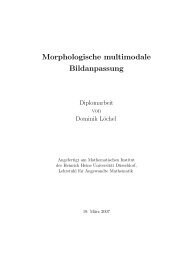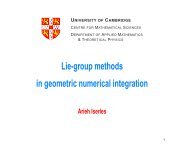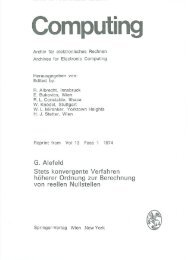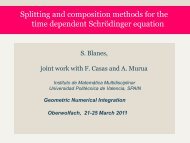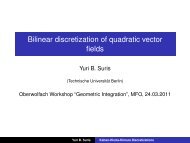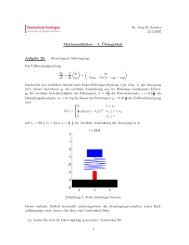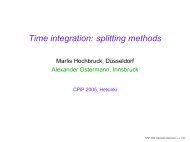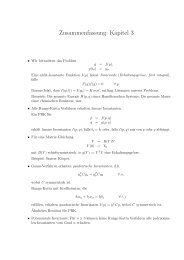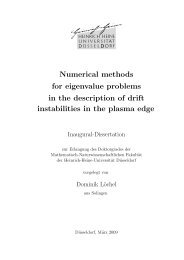Semi-implicit semi-Lagrangian methods for numerical weather ...
Semi-implicit semi-Lagrangian methods for numerical weather ...
Semi-implicit semi-Lagrangian methods for numerical weather ...
You also want an ePaper? Increase the reach of your titles
YUMPU automatically turns print PDFs into web optimized ePapers that Google loves.
<strong>Semi</strong>-Implicit<br />
<strong>Semi</strong>-<br />
<strong>Lagrangian</strong><br />
Time-<br />
Stepping<br />
Methods and<br />
Regularized<br />
Fluid<br />
Equations in<br />
Numerical<br />
Weather<br />
Prediction<br />
Sebastian<br />
Reich<br />
Numerical<br />
Weather<br />
Prediction<br />
Basic Facts<br />
Unified Model<br />
Towards a<br />
New Dynamic<br />
Core<br />
Model System and<br />
Basic Ideas<br />
Results<br />
General<br />
Methodology<br />
Concluding<br />
Remarks<br />
<strong>Semi</strong>-Implicit <strong>Semi</strong>-<strong>Lagrangian</strong><br />
Time-Stepping Methods and<br />
Regularized Fluid Equations in<br />
Numerical Weather Prediction<br />
Sebastian Reich<br />
Institut für Mathematik<br />
Universität Potsdam<br />
Oberwolfach, March 2006
<strong>Semi</strong>-Implicit<br />
<strong>Semi</strong>-<br />
<strong>Lagrangian</strong><br />
Time-<br />
Stepping<br />
Methods and<br />
Regularized<br />
Fluid<br />
Equations in<br />
Numerical<br />
Weather<br />
Prediction<br />
Sebastian<br />
Reich<br />
Numerical<br />
Weather<br />
Prediction<br />
Basic Facts<br />
Unified Model<br />
Towards a<br />
New Dynamic<br />
Core<br />
Model System and<br />
Basic Ideas<br />
Results<br />
General<br />
Methodology<br />
Concluding<br />
Remarks<br />
Outline<br />
1 Numerical Weather Prediction<br />
Basic Facts<br />
Unified Model<br />
2 Towards a New Dynamic Core<br />
Model System and Basic Ideas<br />
Results<br />
General Methodology<br />
Concluding Remarks
<strong>Semi</strong>-Implicit<br />
<strong>Semi</strong>-<br />
<strong>Lagrangian</strong><br />
Time-<br />
Stepping<br />
Methods and<br />
Regularized<br />
Fluid<br />
Equations in<br />
Numerical<br />
Weather<br />
Prediction<br />
Sebastian<br />
Reich<br />
Numerical<br />
Weather<br />
Prediction<br />
Basic Facts<br />
Unified Model<br />
Towards a<br />
New Dynamic<br />
Core<br />
Model System and<br />
Basic Ideas<br />
Results<br />
General<br />
Methodology<br />
Concluding<br />
Remarks<br />
Key Components of Numerical Weather<br />
Prediction<br />
Data assimilation (under-resolved initial data)<br />
Dynamic core (Navier-Stokes or Euler equations)<br />
Parametrisation/physics (clouds, precipitation etc)
<strong>Semi</strong>-Implicit<br />
<strong>Semi</strong>-<br />
<strong>Lagrangian</strong><br />
Time-<br />
Stepping<br />
Methods and<br />
Regularized<br />
Fluid<br />
Equations in<br />
Numerical<br />
Weather<br />
Prediction<br />
Sebastian<br />
Reich<br />
Numerical<br />
Weather<br />
Prediction<br />
Basic Facts<br />
Unified Model<br />
Towards a<br />
New Dynamic<br />
Core<br />
Model System and<br />
Basic Ideas<br />
Results<br />
General<br />
Methodology<br />
Concluding<br />
Remarks<br />
Key Components of Numerical Weather<br />
Prediction<br />
Data assimilation (under-resolved initial data)<br />
Dynamic core (Navier-Stokes or Euler equations)<br />
Parametrisation/physics (clouds, precipitation etc)
<strong>Semi</strong>-Implicit<br />
<strong>Semi</strong>-<br />
<strong>Lagrangian</strong><br />
Time-<br />
Stepping<br />
Methods and<br />
Regularized<br />
Fluid<br />
Equations in<br />
Numerical<br />
Weather<br />
Prediction<br />
Sebastian<br />
Reich<br />
Numerical<br />
Weather<br />
Prediction<br />
Basic Facts<br />
Unified Model<br />
Towards a<br />
New Dynamic<br />
Core<br />
Model System and<br />
Basic Ideas<br />
Results<br />
General<br />
Methodology<br />
Concluding<br />
Remarks<br />
Key Components of Numerical Weather<br />
Prediction<br />
Data assimilation (under-resolved initial data)<br />
Dynamic core (Navier-Stokes or Euler equations)<br />
Parametrisation/physics (clouds, precipitation etc)
<strong>Semi</strong>-Implicit<br />
<strong>Semi</strong>-<br />
<strong>Lagrangian</strong><br />
Time-<br />
Stepping<br />
Methods and<br />
Regularized<br />
Fluid<br />
Equations in<br />
Numerical<br />
Weather<br />
Prediction<br />
Sebastian<br />
Reich<br />
Numerical<br />
Weather<br />
Prediction<br />
Basic Facts<br />
Unified Model<br />
Towards a<br />
New Dynamic<br />
Core<br />
Model System and<br />
Basic Ideas<br />
Results<br />
General<br />
Methodology<br />
Concluding<br />
Remarks<br />
Dynamic Core<br />
Euler equations <strong>for</strong> adiabatic motion<br />
Dv<br />
Dt = −cpθ∇xπ − gk − f k × v,<br />
Dθ<br />
= 0,<br />
dt<br />
Dρ<br />
Dt = −ρ∇x · v,<br />
θ > 0 is potential temperature, ρ is density, k = (0, 0, 1) T , g<br />
is gravity, f is twice the planetary angular velocity, and π is<br />
Exner’s function:<br />
π ≡ (ρθ/ρoTo) R/cv .
<strong>Semi</strong>-Implicit<br />
<strong>Semi</strong>-<br />
<strong>Lagrangian</strong><br />
Time-<br />
Stepping<br />
Methods and<br />
Regularized<br />
Fluid<br />
Equations in<br />
Numerical<br />
Weather<br />
Prediction<br />
Sebastian<br />
Reich<br />
Numerical<br />
Weather<br />
Prediction<br />
Basic Facts<br />
Unified Model<br />
Towards a<br />
New Dynamic<br />
Core<br />
Model System and<br />
Basic Ideas<br />
Results<br />
General<br />
Methodology<br />
Concluding<br />
Remarks<br />
Conservation Properties<br />
Equations are Hamiltonian in both the Eulerian and<br />
<strong>Lagrangian</strong> <strong>for</strong>mulation.<br />
Relabeling symmetry leads to Ertel’s conservation law<br />
of potential vorticity and corresponding Kasimir’s in the<br />
Eulerian picture.<br />
Conservation of mass and momentum is explicitly built<br />
in.<br />
Importance of conservative discretization <strong>methods</strong> was<br />
realized early on by Arakawa and Lorenz.<br />
Two systematic approaches to conservative<br />
discretizations:<br />
Nambu bracket discretizations (Arakawa, Salmon,<br />
Nevir)<br />
Particle <strong>methods</strong> (Salmon, Frank, Gottwald, Reich)
<strong>Semi</strong>-Implicit<br />
<strong>Semi</strong>-<br />
<strong>Lagrangian</strong><br />
Time-<br />
Stepping<br />
Methods and<br />
Regularized<br />
Fluid<br />
Equations in<br />
Numerical<br />
Weather<br />
Prediction<br />
Sebastian<br />
Reich<br />
Numerical<br />
Weather<br />
Prediction<br />
Basic Facts<br />
Unified Model<br />
Towards a<br />
New Dynamic<br />
Core<br />
Model System and<br />
Basic Ideas<br />
Results<br />
General<br />
Methodology<br />
Concluding<br />
Remarks<br />
Conservation Properties<br />
Equations are Hamiltonian in both the Eulerian and<br />
<strong>Lagrangian</strong> <strong>for</strong>mulation.<br />
Relabeling symmetry leads to Ertel’s conservation law<br />
of potential vorticity and corresponding Kasimir’s in the<br />
Eulerian picture.<br />
Conservation of mass and momentum is explicitly built<br />
in.<br />
Importance of conservative discretization <strong>methods</strong> was<br />
realized early on by Arakawa and Lorenz.<br />
Two systematic approaches to conservative<br />
discretizations:<br />
Nambu bracket discretizations (Arakawa, Salmon,<br />
Nevir)<br />
Particle <strong>methods</strong> (Salmon, Frank, Gottwald, Reich)
<strong>Semi</strong>-Implicit<br />
<strong>Semi</strong>-<br />
<strong>Lagrangian</strong><br />
Time-<br />
Stepping<br />
Methods and<br />
Regularized<br />
Fluid<br />
Equations in<br />
Numerical<br />
Weather<br />
Prediction<br />
Sebastian<br />
Reich<br />
Numerical<br />
Weather<br />
Prediction<br />
Basic Facts<br />
Unified Model<br />
Towards a<br />
New Dynamic<br />
Core<br />
Model System and<br />
Basic Ideas<br />
Results<br />
General<br />
Methodology<br />
Concluding<br />
Remarks<br />
Conservation Properties<br />
Equations are Hamiltonian in both the Eulerian and<br />
<strong>Lagrangian</strong> <strong>for</strong>mulation.<br />
Relabeling symmetry leads to Ertel’s conservation law<br />
of potential vorticity and corresponding Kasimir’s in the<br />
Eulerian picture.<br />
Conservation of mass and momentum is explicitly built<br />
in.<br />
Importance of conservative discretization <strong>methods</strong> was<br />
realized early on by Arakawa and Lorenz.<br />
Two systematic approaches to conservative<br />
discretizations:<br />
Nambu bracket discretizations (Arakawa, Salmon,<br />
Nevir)<br />
Particle <strong>methods</strong> (Salmon, Frank, Gottwald, Reich)
<strong>Semi</strong>-Implicit<br />
<strong>Semi</strong>-<br />
<strong>Lagrangian</strong><br />
Time-<br />
Stepping<br />
Methods and<br />
Regularized<br />
Fluid<br />
Equations in<br />
Numerical<br />
Weather<br />
Prediction<br />
Sebastian<br />
Reich<br />
Numerical<br />
Weather<br />
Prediction<br />
Basic Facts<br />
Unified Model<br />
Towards a<br />
New Dynamic<br />
Core<br />
Model System and<br />
Basic Ideas<br />
Results<br />
General<br />
Methodology<br />
Concluding<br />
Remarks<br />
Conservation Properties<br />
Equations are Hamiltonian in both the Eulerian and<br />
<strong>Lagrangian</strong> <strong>for</strong>mulation.<br />
Relabeling symmetry leads to Ertel’s conservation law<br />
of potential vorticity and corresponding Kasimir’s in the<br />
Eulerian picture.<br />
Conservation of mass and momentum is explicitly built<br />
in.<br />
Importance of conservative discretization <strong>methods</strong> was<br />
realized early on by Arakawa and Lorenz.<br />
Two systematic approaches to conservative<br />
discretizations:<br />
Nambu bracket discretizations (Arakawa, Salmon,<br />
Nevir)<br />
Particle <strong>methods</strong> (Salmon, Frank, Gottwald, Reich)
<strong>Semi</strong>-Implicit<br />
<strong>Semi</strong>-<br />
<strong>Lagrangian</strong><br />
Time-<br />
Stepping<br />
Methods and<br />
Regularized<br />
Fluid<br />
Equations in<br />
Numerical<br />
Weather<br />
Prediction<br />
Sebastian<br />
Reich<br />
Numerical<br />
Weather<br />
Prediction<br />
Basic Facts<br />
Unified Model<br />
Towards a<br />
New Dynamic<br />
Core<br />
Model System and<br />
Basic Ideas<br />
Results<br />
General<br />
Methodology<br />
Concluding<br />
Remarks<br />
Conservation Properties<br />
Equations are Hamiltonian in both the Eulerian and<br />
<strong>Lagrangian</strong> <strong>for</strong>mulation.<br />
Relabeling symmetry leads to Ertel’s conservation law<br />
of potential vorticity and corresponding Kasimir’s in the<br />
Eulerian picture.<br />
Conservation of mass and momentum is explicitly built<br />
in.<br />
Importance of conservative discretization <strong>methods</strong> was<br />
realized early on by Arakawa and Lorenz.<br />
Two systematic approaches to conservative<br />
discretizations:<br />
Nambu bracket discretizations (Arakawa, Salmon,<br />
Nevir)<br />
Particle <strong>methods</strong> (Salmon, Frank, Gottwald, Reich)
<strong>Semi</strong>-Implicit<br />
<strong>Semi</strong>-<br />
<strong>Lagrangian</strong><br />
Time-<br />
Stepping<br />
Methods and<br />
Regularized<br />
Fluid<br />
Equations in<br />
Numerical<br />
Weather<br />
Prediction<br />
Sebastian<br />
Reich<br />
Numerical<br />
Weather<br />
Prediction<br />
Basic Facts<br />
Unified Model<br />
Towards a<br />
New Dynamic<br />
Core<br />
Model System and<br />
Basic Ideas<br />
Results<br />
General<br />
Methodology<br />
Concluding<br />
Remarks<br />
Linearized Equations<br />
We consider linearization about a stationary isothermal reference<br />
state on an f -plane.
<strong>Semi</strong>-Implicit<br />
<strong>Semi</strong>-<br />
<strong>Lagrangian</strong><br />
Time-<br />
Stepping<br />
Methods and<br />
Regularized<br />
Fluid<br />
Equations in<br />
Numerical<br />
Weather<br />
Prediction<br />
Sebastian<br />
Reich<br />
Numerical<br />
Weather<br />
Prediction<br />
Basic Facts<br />
Unified Model<br />
Towards a<br />
New Dynamic<br />
Core<br />
Model System and<br />
Basic Ideas<br />
Results<br />
General<br />
Methodology<br />
Concluding<br />
Remarks<br />
Linearized Equations
<strong>Semi</strong>-Implicit<br />
<strong>Semi</strong>-<br />
<strong>Lagrangian</strong><br />
Time-<br />
Stepping<br />
Methods and<br />
Regularized<br />
Fluid<br />
Equations in<br />
Numerical<br />
Weather<br />
Prediction<br />
Sebastian<br />
Reich<br />
Numerical<br />
Weather<br />
Prediction<br />
Basic Facts<br />
Unified Model<br />
Towards a<br />
New Dynamic<br />
Core<br />
Model System and<br />
Basic Ideas<br />
Results<br />
General<br />
Methodology<br />
Concluding<br />
Remarks<br />
Linearized Equations<br />
The hydrostatic approximation neglects the vertical acceleration<br />
in the vertical momentum equation, i.e.,<br />
0 = Dw<br />
Dt = −cpθπz − g.<br />
We again consider the effect on the linearization about a stationary<br />
isothermal reference state on an f -plane.
<strong>Semi</strong>-Implicit<br />
<strong>Semi</strong>-<br />
<strong>Lagrangian</strong><br />
Time-<br />
Stepping<br />
Methods and<br />
Regularized<br />
Fluid<br />
Equations in<br />
Numerical<br />
Weather<br />
Prediction<br />
Sebastian<br />
Reich<br />
Numerical<br />
Weather<br />
Prediction<br />
Basic Facts<br />
Unified Model<br />
Towards a<br />
New Dynamic<br />
Core<br />
Model System and<br />
Basic Ideas<br />
Results<br />
General<br />
Methodology<br />
Concluding<br />
Remarks<br />
Linearized Equations
<strong>Semi</strong>-Implicit<br />
<strong>Semi</strong>-<br />
<strong>Lagrangian</strong><br />
Time-<br />
Stepping<br />
Methods and<br />
Regularized<br />
Fluid<br />
Equations in<br />
Numerical<br />
Weather<br />
Prediction<br />
Sebastian<br />
Reich<br />
Numerical<br />
Weather<br />
Prediction<br />
Basic Facts<br />
Unified Model<br />
Towards a<br />
New Dynamic<br />
Core<br />
Model System and<br />
Basic Ideas<br />
Results<br />
General<br />
Methodology<br />
Concluding<br />
Remarks<br />
The UK Met Office Unified Model Approach<br />
Methodology<br />
One and the same set of dynamical equations (i.e. the<br />
unapproximated Euler/Navier-Stokes equations) are<br />
solved <strong>for</strong> problems on all length and time scales (i.e.,<br />
from climate over global to regional and local models).<br />
The numerics and in particular the time-stepping<br />
procedure should take care of the unresolved time and<br />
length-scales as appropriate.<br />
It is ‘clear’ that this can only be achieved by an<br />
unconditionally stable <strong>implicit</strong> time-stepping method.<br />
Conservation properties become important <strong>for</strong> medium<br />
range <strong>weather</strong> <strong>for</strong>ecast and long range climate<br />
predictions.
<strong>Semi</strong>-Implicit<br />
<strong>Semi</strong>-<br />
<strong>Lagrangian</strong><br />
Time-<br />
Stepping<br />
Methods and<br />
Regularized<br />
Fluid<br />
Equations in<br />
Numerical<br />
Weather<br />
Prediction<br />
Sebastian<br />
Reich<br />
Numerical<br />
Weather<br />
Prediction<br />
Basic Facts<br />
Unified Model<br />
Towards a<br />
New Dynamic<br />
Core<br />
Model System and<br />
Basic Ideas<br />
Results<br />
General<br />
Methodology<br />
Concluding<br />
Remarks<br />
The UK Met Office Unified Model Approach<br />
Methodology<br />
One and the same set of dynamical equations (i.e. the<br />
unapproximated Euler/Navier-Stokes equations) are<br />
solved <strong>for</strong> problems on all length and time scales (i.e.,<br />
from climate over global to regional and local models).<br />
The numerics and in particular the time-stepping<br />
procedure should take care of the unresolved time and<br />
length-scales as appropriate.<br />
It is ‘clear’ that this can only be achieved by an<br />
unconditionally stable <strong>implicit</strong> time-stepping method.<br />
Conservation properties become important <strong>for</strong> medium<br />
range <strong>weather</strong> <strong>for</strong>ecast and long range climate<br />
predictions.
<strong>Semi</strong>-Implicit<br />
<strong>Semi</strong>-<br />
<strong>Lagrangian</strong><br />
Time-<br />
Stepping<br />
Methods and<br />
Regularized<br />
Fluid<br />
Equations in<br />
Numerical<br />
Weather<br />
Prediction<br />
Sebastian<br />
Reich<br />
Numerical<br />
Weather<br />
Prediction<br />
Basic Facts<br />
Unified Model<br />
Towards a<br />
New Dynamic<br />
Core<br />
Model System and<br />
Basic Ideas<br />
Results<br />
General<br />
Methodology<br />
Concluding<br />
Remarks<br />
The UK Met Office Unified Model Approach<br />
Methodology<br />
One and the same set of dynamical equations (i.e. the<br />
unapproximated Euler/Navier-Stokes equations) are<br />
solved <strong>for</strong> problems on all length and time scales (i.e.,<br />
from climate over global to regional and local models).<br />
The numerics and in particular the time-stepping<br />
procedure should take care of the unresolved time and<br />
length-scales as appropriate.<br />
It is ‘clear’ that this can only be achieved by an<br />
unconditionally stable <strong>implicit</strong> time-stepping method.<br />
Conservation properties become important <strong>for</strong> medium<br />
range <strong>weather</strong> <strong>for</strong>ecast and long range climate<br />
predictions.
<strong>Semi</strong>-Implicit<br />
<strong>Semi</strong>-<br />
<strong>Lagrangian</strong><br />
Time-<br />
Stepping<br />
Methods and<br />
Regularized<br />
Fluid<br />
Equations in<br />
Numerical<br />
Weather<br />
Prediction<br />
Sebastian<br />
Reich<br />
Numerical<br />
Weather<br />
Prediction<br />
Basic Facts<br />
Unified Model<br />
Towards a<br />
New Dynamic<br />
Core<br />
Model System and<br />
Basic Ideas<br />
Results<br />
General<br />
Methodology<br />
Concluding<br />
Remarks<br />
The UK Met Office Unified Model Approach<br />
Methodology<br />
One and the same set of dynamical equations (i.e. the<br />
unapproximated Euler/Navier-Stokes equations) are<br />
solved <strong>for</strong> problems on all length and time scales (i.e.,<br />
from climate over global to regional and local models).<br />
The numerics and in particular the time-stepping<br />
procedure should take care of the unresolved time and<br />
length-scales as appropriate.<br />
It is ‘clear’ that this can only be achieved by an<br />
unconditionally stable <strong>implicit</strong> time-stepping method.<br />
Conservation properties become important <strong>for</strong> medium<br />
range <strong>weather</strong> <strong>for</strong>ecast and long range climate<br />
predictions.
<strong>Semi</strong>-Implicit<br />
<strong>Semi</strong>-<br />
<strong>Lagrangian</strong><br />
Time-<br />
Stepping<br />
Methods and<br />
Regularized<br />
Fluid<br />
Equations in<br />
Numerical<br />
Weather<br />
Prediction<br />
Sebastian<br />
Reich<br />
Numerical<br />
Weather<br />
Prediction<br />
Basic Facts<br />
Unified Model<br />
Towards a<br />
New Dynamic<br />
Core<br />
Model System and<br />
Basic Ideas<br />
Results<br />
General<br />
Methodology<br />
Concluding<br />
Remarks<br />
The <strong>Semi</strong>-Implicit <strong>Semi</strong>-<strong>Lagrangian</strong> (SISL)<br />
Method<br />
The <strong>Semi</strong>-Implicit Part<br />
There is only one method that ‘comes to mind’. It is called<br />
the <strong>semi</strong>-<strong>implicit</strong> method in the meteorology community and<br />
the θ-method in <strong>numerical</strong> analysis:<br />
z n+1 − z n<br />
∆t<br />
= θf(z n+1 ) + (1 − θ)f(z n ).<br />
For θ = 1/2, it becomes the trapezoidal rule and, <strong>for</strong> θ = 1,<br />
it is the <strong>implicit</strong> Euler method.<br />
The <strong>Semi</strong>-<strong>Lagrangian</strong> Part<br />
Advection is treated in a <strong>semi</strong>-<strong>Lagrangian</strong> fashion.
<strong>Semi</strong>-Implicit<br />
<strong>Semi</strong>-<br />
<strong>Lagrangian</strong><br />
Time-<br />
Stepping<br />
Methods and<br />
Regularized<br />
Fluid<br />
Equations in<br />
Numerical<br />
Weather<br />
Prediction<br />
Sebastian<br />
Reich<br />
Numerical<br />
Weather<br />
Prediction<br />
Basic Facts<br />
Unified Model<br />
Towards a<br />
New Dynamic<br />
Core<br />
Model System and<br />
Basic Ideas<br />
Results<br />
General<br />
Methodology<br />
Concluding<br />
Remarks<br />
The <strong>Semi</strong>-Implicit <strong>Semi</strong>-<strong>Lagrangian</strong> (SISL)<br />
Method<br />
The <strong>Semi</strong>-Implicit Part<br />
There is only one method that ‘comes to mind’. It is called<br />
the <strong>semi</strong>-<strong>implicit</strong> method in the meteorology community and<br />
the θ-method in <strong>numerical</strong> analysis:<br />
z n+1 − z n<br />
∆t<br />
= θf(z n+1 ) + (1 − θ)f(z n ).<br />
For θ = 1/2, it becomes the trapezoidal rule and, <strong>for</strong> θ = 1,<br />
it is the <strong>implicit</strong> Euler method.<br />
The <strong>Semi</strong>-<strong>Lagrangian</strong> Part<br />
Advection is treated in a <strong>semi</strong>-<strong>Lagrangian</strong> fashion.
<strong>Semi</strong>-Implicit<br />
<strong>Semi</strong>-<br />
<strong>Lagrangian</strong><br />
Time-<br />
Stepping<br />
Methods and<br />
Regularized<br />
Fluid<br />
Equations in<br />
Numerical<br />
Weather<br />
Prediction<br />
Sebastian<br />
Reich<br />
Numerical<br />
Weather<br />
Prediction<br />
Basic Facts<br />
Unified Model<br />
Towards a<br />
New Dynamic<br />
Core<br />
Model System and<br />
Basic Ideas<br />
Results<br />
General<br />
Methodology<br />
Concluding<br />
Remarks<br />
Results <strong>for</strong> θ = 1/2<br />
We apply the <strong>semi</strong>-<strong>implicit</strong> method to the linearized equations<br />
with θ = 1/2.
<strong>Semi</strong>-Implicit<br />
<strong>Semi</strong>-<br />
<strong>Lagrangian</strong><br />
Time-<br />
Stepping<br />
Methods and<br />
Regularized<br />
Fluid<br />
Equations in<br />
Numerical<br />
Weather<br />
Prediction<br />
Sebastian<br />
Reich<br />
Numerical<br />
Weather<br />
Prediction<br />
Basic Facts<br />
Unified Model<br />
Towards a<br />
New Dynamic<br />
Core<br />
Model System and<br />
Basic Ideas<br />
Results<br />
General<br />
Methodology<br />
Concluding<br />
Remarks<br />
Results <strong>for</strong> θ = 1/2<br />
Step-size ∆t = 30 min.
<strong>Semi</strong>-Implicit<br />
<strong>Semi</strong>-<br />
<strong>Lagrangian</strong><br />
Time-<br />
Stepping<br />
Methods and<br />
Regularized<br />
Fluid<br />
Equations in<br />
Numerical<br />
Weather<br />
Prediction<br />
Sebastian<br />
Reich<br />
Numerical<br />
Weather<br />
Prediction<br />
Basic Facts<br />
Unified Model<br />
Towards a<br />
New Dynamic<br />
Core<br />
Model System and<br />
Basic Ideas<br />
Results<br />
General<br />
Methodology<br />
Concluding<br />
Remarks<br />
Results <strong>for</strong> θ = 1/2<br />
Step-size ∆t = 1 min.
<strong>Semi</strong>-Implicit<br />
<strong>Semi</strong>-<br />
<strong>Lagrangian</strong><br />
Time-<br />
Stepping<br />
Methods and<br />
Regularized<br />
Fluid<br />
Equations in<br />
Numerical<br />
Weather<br />
Prediction<br />
Sebastian<br />
Reich<br />
Numerical<br />
Weather<br />
Prediction<br />
Basic Facts<br />
Unified Model<br />
Towards a<br />
New Dynamic<br />
Core<br />
Model System and<br />
Basic Ideas<br />
Results<br />
General<br />
Methodology<br />
Concluding<br />
Remarks<br />
Results <strong>for</strong> θ = 1/2<br />
Step-size ∆t = 10 sec.
<strong>Semi</strong>-Implicit<br />
<strong>Semi</strong>-<br />
<strong>Lagrangian</strong><br />
Time-<br />
Stepping<br />
Methods and<br />
Regularized<br />
Fluid<br />
Equations in<br />
Numerical<br />
Weather<br />
Prediction<br />
Sebastian<br />
Reich<br />
Numerical<br />
Weather<br />
Prediction<br />
Basic Facts<br />
Unified Model<br />
Towards a<br />
New Dynamic<br />
Core<br />
Model System and<br />
Basic Ideas<br />
Results<br />
General<br />
Methodology<br />
Concluding<br />
Remarks<br />
Implementation Issues<br />
Positive Aspects<br />
The sign of the group velocity is preserved (although the<br />
sound waves are slowed down to essentially zero group<br />
velocity).<br />
Not so Positive Aspects<br />
The fully <strong>implicit</strong> method is too expensive. Simplifications<br />
need to be applied such as<br />
<strong>semi</strong>-<strong>implicit</strong> predictor-corrector method (i.e., a linearly<br />
<strong>implicit</strong> method),<br />
extrapolated trajectory calculation in the<br />
<strong>semi</strong>-<strong>Lagrangian</strong> part.
<strong>Semi</strong>-Implicit<br />
<strong>Semi</strong>-<br />
<strong>Lagrangian</strong><br />
Time-<br />
Stepping<br />
Methods and<br />
Regularized<br />
Fluid<br />
Equations in<br />
Numerical<br />
Weather<br />
Prediction<br />
Sebastian<br />
Reich<br />
Numerical<br />
Weather<br />
Prediction<br />
Basic Facts<br />
Unified Model<br />
Towards a<br />
New Dynamic<br />
Core<br />
Model System and<br />
Basic Ideas<br />
Results<br />
General<br />
Methodology<br />
Concluding<br />
Remarks<br />
Implementation Issues<br />
Positive Aspects<br />
The sign of the group velocity is preserved (although the<br />
sound waves are slowed down to essentially zero group<br />
velocity).<br />
Not so Positive Aspects<br />
The fully <strong>implicit</strong> method is too expensive. Simplifications<br />
need to be applied such as<br />
<strong>semi</strong>-<strong>implicit</strong> predictor-corrector method (i.e., a linearly<br />
<strong>implicit</strong> method),<br />
extrapolated trajectory calculation in the<br />
<strong>semi</strong>-<strong>Lagrangian</strong> part.
<strong>Semi</strong>-Implicit<br />
<strong>Semi</strong>-<br />
<strong>Lagrangian</strong><br />
Time-<br />
Stepping<br />
Methods and<br />
Regularized<br />
Fluid<br />
Equations in<br />
Numerical<br />
Weather<br />
Prediction<br />
Sebastian<br />
Reich<br />
Numerical<br />
Weather<br />
Prediction<br />
Basic Facts<br />
Unified Model<br />
Towards a<br />
New Dynamic<br />
Core<br />
Model System and<br />
Basic Ideas<br />
Results<br />
General<br />
Methodology<br />
Concluding<br />
Remarks<br />
Outline<br />
1 Numerical Weather Prediction<br />
Basic Facts<br />
Unified Model<br />
2 Towards a New Dynamic Core<br />
Model System and Basic Ideas<br />
Results<br />
General Methodology<br />
Concluding Remarks
<strong>Semi</strong>-Implicit<br />
<strong>Semi</strong>-<br />
<strong>Lagrangian</strong><br />
Time-<br />
Stepping<br />
Methods and<br />
Regularized<br />
Fluid<br />
Equations in<br />
Numerical<br />
Weather<br />
Prediction<br />
Sebastian<br />
Reich<br />
Numerical<br />
Weather<br />
Prediction<br />
Basic Facts<br />
Unified Model<br />
Towards a<br />
New Dynamic<br />
Core<br />
Model System and<br />
Basic Ideas<br />
Results<br />
General<br />
Methodology<br />
Concluding<br />
Remarks<br />
Model Equations<br />
Shallow-Water Equations<br />
du<br />
dt = −g∇xh − f k × u,<br />
dh<br />
dt<br />
= −h∇ · u,<br />
u = (u, v) T , x = (x, y) T , h is the fluid depth, k = (0, 0, 1) T .<br />
Geostrophic Motion and Waves<br />
Slow geostrophic motion is governed by the <strong>for</strong>ce balance<br />
0 ≈ −g∇xh − f k × u,<br />
while fast inertia-gravity waves are characterized by<br />
htt = −f 2 h + g∇ 2 xh.
<strong>Semi</strong>-Implicit<br />
<strong>Semi</strong>-<br />
<strong>Lagrangian</strong><br />
Time-<br />
Stepping<br />
Methods and<br />
Regularized<br />
Fluid<br />
Equations in<br />
Numerical<br />
Weather<br />
Prediction<br />
Sebastian<br />
Reich<br />
Numerical<br />
Weather<br />
Prediction<br />
Basic Facts<br />
Unified Model<br />
Towards a<br />
New Dynamic<br />
Core<br />
Model System and<br />
Basic Ideas<br />
Results<br />
General<br />
Methodology<br />
Concluding<br />
Remarks<br />
Model Equations<br />
Shallow-Water Equations<br />
du<br />
dt = −g∇xh − f k × u,<br />
dh<br />
dt<br />
= −h∇ · u,<br />
u = (u, v) T , x = (x, y) T , h is the fluid depth, k = (0, 0, 1) T .<br />
Geostrophic Motion and Waves<br />
Slow geostrophic motion is governed by the <strong>for</strong>ce balance<br />
0 ≈ −g∇xh − f k × u,<br />
while fast inertia-gravity waves are characterized by<br />
htt = −f 2 h + g∇ 2 xh.
<strong>Semi</strong>-Implicit<br />
<strong>Semi</strong>-<br />
<strong>Lagrangian</strong><br />
Time-<br />
Stepping<br />
Methods and<br />
Regularized<br />
Fluid<br />
Equations in<br />
Numerical<br />
Weather<br />
Prediction<br />
Sebastian<br />
Reich<br />
Numerical<br />
Weather<br />
Prediction<br />
Basic Facts<br />
Unified Model<br />
Towards a<br />
New Dynamic<br />
Core<br />
Model System and<br />
Basic Ideas<br />
Results<br />
General<br />
Methodology<br />
Concluding<br />
Remarks<br />
Two Alternative Time-Stepping Methods<br />
‘Perfect’ <strong>Semi</strong>-Implicit Method<br />
un+1 − un ∆t<br />
xn+1 − xn ∆t<br />
ln hn+1 − ln hn ∆t<br />
= − g<br />
2 ∇x(h n+1 + h n ) − f<br />
2 k × (un+1 + u n ),<br />
= 1<br />
2 (un+1 + u n ),<br />
= − 1<br />
2<br />
<br />
∇ · u n+1 + ∇ · u n<br />
.
<strong>Semi</strong>-Implicit<br />
<strong>Semi</strong>-<br />
<strong>Lagrangian</strong><br />
Time-<br />
Stepping<br />
Methods and<br />
Regularized<br />
Fluid<br />
Equations in<br />
Numerical<br />
Weather<br />
Prediction<br />
Sebastian<br />
Reich<br />
Numerical<br />
Weather<br />
Prediction<br />
Basic Facts<br />
Unified Model<br />
Towards a<br />
New Dynamic<br />
Core<br />
Model System and<br />
Basic Ideas<br />
Results<br />
General<br />
Methodology<br />
Concluding<br />
Remarks<br />
Two Alternative Time-Stepping Methods<br />
Regularized leapfrog method (Frank, Gottwald, Reich)<br />
un+1 − un ∆t<br />
xn+1/2 − xn−1/2 ∆t<br />
ln hn+1/2 − ln hn−1/2 where<br />
∆t<br />
= −g∇x ˜ h n+1/2 − f<br />
2 k × (un+1 + u n ),<br />
= u n ,<br />
= −∇ · u n ,<br />
˜h = (1 + γ 2 − α 2 ∇ 2 x) −1 h.
<strong>Semi</strong>-Implicit<br />
<strong>Semi</strong>-<br />
<strong>Lagrangian</strong><br />
Time-<br />
Stepping<br />
Methods and<br />
Regularized<br />
Fluid<br />
Equations in<br />
Numerical<br />
Weather<br />
Prediction<br />
Sebastian<br />
Reich<br />
Numerical<br />
Weather<br />
Prediction<br />
Basic Facts<br />
Unified Model<br />
Towards a<br />
New Dynamic<br />
Core<br />
Model System and<br />
Basic Ideas<br />
Results<br />
General<br />
Methodology<br />
Concluding<br />
Remarks<br />
Improved Regularization<br />
Linear Waves<br />
On a linearized equation level both discretizations behave<br />
the same <strong>for</strong> waves provided that [Frank et al 2004]<br />
<br />
f ∆t<br />
gH∆t<br />
γ = , α = .<br />
2 2<br />
However, the geostrophic mode is distorted.<br />
Balanced Regularization<br />
Improved regularization [Wood, Stani<strong>for</strong>th, Reich, 2005]:<br />
(1 + γ 2 − α 2 ∇ 2 <br />
) ˜h − h = α 2<br />
<br />
∇ 2 h − f<br />
g (vx<br />
<br />
− uy)
<strong>Semi</strong>-Implicit<br />
<strong>Semi</strong>-<br />
<strong>Lagrangian</strong><br />
Time-<br />
Stepping<br />
Methods and<br />
Regularized<br />
Fluid<br />
Equations in<br />
Numerical<br />
Weather<br />
Prediction<br />
Sebastian<br />
Reich<br />
Numerical<br />
Weather<br />
Prediction<br />
Basic Facts<br />
Unified Model<br />
Towards a<br />
New Dynamic<br />
Core<br />
Model System and<br />
Basic Ideas<br />
Results<br />
General<br />
Methodology<br />
Concluding<br />
Remarks<br />
Improved Regularization<br />
Linear Waves<br />
On a linearized equation level both discretizations behave<br />
the same <strong>for</strong> waves provided that [Frank et al 2004]<br />
<br />
f ∆t<br />
gH∆t<br />
γ = , α = .<br />
2 2<br />
However, the geostrophic mode is distorted.<br />
Balanced Regularization<br />
Improved regularization [Wood, Stani<strong>for</strong>th, Reich, 2005]:<br />
(1 + γ 2 − α 2 ∇ 2 <br />
) ˜h − h = α 2<br />
<br />
∇ 2 h − f<br />
g (vx<br />
<br />
− uy)
<strong>Semi</strong>-Implicit<br />
<strong>Semi</strong>-<br />
<strong>Lagrangian</strong><br />
Time-<br />
Stepping<br />
Methods and<br />
Regularized<br />
Fluid<br />
Equations in<br />
Numerical<br />
Weather<br />
Prediction<br />
Sebastian<br />
Reich<br />
Numerical<br />
Weather<br />
Prediction<br />
Basic Facts<br />
Unified Model<br />
Towards a<br />
New Dynamic<br />
Core<br />
Model System and<br />
Basic Ideas<br />
Results<br />
General<br />
Methodology<br />
Concluding<br />
Remarks<br />
Time-Staggered <strong>Semi</strong>-<strong>Lagrangian</strong> Method<br />
The regularized staggered <strong>for</strong>mulation can be implemented<br />
efficiently within the <strong>semi</strong>-<strong>Lagrangian</strong> framework [Stani<strong>for</strong>th,<br />
Wood, Reich, 2006], [Reich, 2006].
<strong>Semi</strong>-Implicit<br />
<strong>Semi</strong>-<br />
<strong>Lagrangian</strong><br />
Time-<br />
Stepping<br />
Methods and<br />
Regularized<br />
Fluid<br />
Equations in<br />
Numerical<br />
Weather<br />
Prediction<br />
Sebastian<br />
Reich<br />
Numerical<br />
Weather<br />
Prediction<br />
Basic Facts<br />
Unified Model<br />
Towards a<br />
New Dynamic<br />
Core<br />
Model System and<br />
Basic Ideas<br />
Results<br />
General<br />
Methodology<br />
Concluding<br />
Remarks<br />
Time-Staggered <strong>Semi</strong>-<strong>Lagrangian</strong> Method<br />
Barotropic instability:
<strong>Semi</strong>-Implicit<br />
<strong>Semi</strong>-<br />
<strong>Lagrangian</strong><br />
Time-<br />
Stepping<br />
Methods and<br />
Regularized<br />
Fluid<br />
Equations in<br />
Numerical<br />
Weather<br />
Prediction<br />
Sebastian<br />
Reich<br />
Numerical<br />
Weather<br />
Prediction<br />
Basic Facts<br />
Unified Model<br />
Towards a<br />
New Dynamic<br />
Core<br />
Model System and<br />
Basic Ideas<br />
Results<br />
General<br />
Methodology<br />
Concluding<br />
Remarks<br />
Time-Staggered <strong>Semi</strong>-<strong>Lagrangian</strong> Method<br />
Vortex merger:
<strong>Semi</strong>-Implicit<br />
<strong>Semi</strong>-<br />
<strong>Lagrangian</strong><br />
Time-<br />
Stepping<br />
Methods and<br />
Regularized<br />
Fluid<br />
Equations in<br />
Numerical<br />
Weather<br />
Prediction<br />
Sebastian<br />
Reich<br />
Numerical<br />
Weather<br />
Prediction<br />
Basic Facts<br />
Unified Model<br />
Towards a<br />
New Dynamic<br />
Core<br />
Model System and<br />
Basic Ideas<br />
Results<br />
General<br />
Methodology<br />
Concluding<br />
Remarks<br />
General Regularization Procedure<br />
Full Euler Equations<br />
Given a hydrostatic reference state (¯θ, ¯π), the regularized<br />
equations take the abstract <strong>for</strong>m<br />
Dv<br />
Dt = −cpθ∇x˜π ′ ˜θ ′<br />
+ gk<br />
¯θ<br />
Dθ<br />
dt<br />
= 0,<br />
Dρ<br />
Dt = −ρ∇x · v,<br />
Here θ = ¯ θ + θ ′ , π = ¯π + π ′ .<br />
− f k × v = Rv,
<strong>Semi</strong>-Implicit<br />
<strong>Semi</strong>-<br />
<strong>Lagrangian</strong><br />
Time-<br />
Stepping<br />
Methods and<br />
Regularized<br />
Fluid<br />
Equations in<br />
Numerical<br />
Weather<br />
Prediction<br />
Sebastian<br />
Reich<br />
Numerical<br />
Weather<br />
Prediction<br />
Basic Facts<br />
Unified Model<br />
Towards a<br />
New Dynamic<br />
Core<br />
Model System and<br />
Basic Ideas<br />
Results<br />
General<br />
Methodology<br />
Concluding<br />
Remarks<br />
General Regularization Procedure<br />
Regularization Procedure<br />
The regularized quantities ˜θ ′ , ˜π ′ are determined by a linear<br />
system of equations such that the following conditions are<br />
satisfied:<br />
Linear equivalence to trapezoidal rule <strong>for</strong> the given<br />
reference state (stability),<br />
˜θ ′ = θ ′ , ˜π ′ = π ′ if Rv = 0 (balance condition).<br />
Use staggered (Störmer-Verlet) discretization in time.
<strong>Semi</strong>-Implicit<br />
<strong>Semi</strong>-<br />
<strong>Lagrangian</strong><br />
Time-<br />
Stepping<br />
Methods and<br />
Regularized<br />
Fluid<br />
Equations in<br />
Numerical<br />
Weather<br />
Prediction<br />
Sebastian<br />
Reich<br />
Numerical<br />
Weather<br />
Prediction<br />
Basic Facts<br />
Unified Model<br />
Towards a<br />
New Dynamic<br />
Core<br />
Model System and<br />
Basic Ideas<br />
Results<br />
General<br />
Methodology<br />
Concluding<br />
Remarks<br />
Vertical Slice Model<br />
Non-hydrostatic test case<br />
Numerical test taken from Pinty et al, 1995. Flow over a<br />
mountain with profile<br />
800 m<br />
h(x) =<br />
1 + ((x − 256 km)/16 km) 2<br />
and mean horizontal velocity of 32 m s −1 . The time-step is<br />
∆t = 2 min. The vertical grid-size is ∆z = 250 m while the<br />
horizontal grid-size is ∆x = 4 km. The smoothing length is<br />
α = cs∆t/2 ≈ 19 km.
<strong>Semi</strong>-Implicit<br />
<strong>Semi</strong>-<br />
<strong>Lagrangian</strong><br />
Time-<br />
Stepping<br />
Methods and<br />
Regularized<br />
Fluid<br />
Equations in<br />
Numerical<br />
Weather<br />
Prediction<br />
Sebastian<br />
Reich<br />
Numerical<br />
Weather<br />
Prediction<br />
Basic Facts<br />
Unified Model<br />
Towards a<br />
New Dynamic<br />
Core<br />
Model System and<br />
Basic Ideas<br />
Results<br />
General<br />
Methodology<br />
Concluding<br />
Remarks<br />
Vertical Slice Model<br />
Numerical dispersion relation:
<strong>Semi</strong>-Implicit<br />
<strong>Semi</strong>-<br />
<strong>Lagrangian</strong><br />
Time-<br />
Stepping<br />
Methods and<br />
Regularized<br />
Fluid<br />
Equations in<br />
Numerical<br />
Weather<br />
Prediction<br />
Sebastian<br />
Reich<br />
Numerical<br />
Weather<br />
Prediction<br />
Basic Facts<br />
Unified Model<br />
Towards a<br />
New Dynamic<br />
Core<br />
Model System and<br />
Basic Ideas<br />
Results<br />
General<br />
Methodology<br />
Concluding<br />
Remarks<br />
Vertical Slice Model<br />
Potential temperature:
<strong>Semi</strong>-Implicit<br />
<strong>Semi</strong>-<br />
<strong>Lagrangian</strong><br />
Time-<br />
Stepping<br />
Methods and<br />
Regularized<br />
Fluid<br />
Equations in<br />
Numerical<br />
Weather<br />
Prediction<br />
Sebastian<br />
Reich<br />
Numerical<br />
Weather<br />
Prediction<br />
Basic Facts<br />
Unified Model<br />
Towards a<br />
New Dynamic<br />
Core<br />
Model System and<br />
Basic Ideas<br />
Results<br />
General<br />
Methodology<br />
Concluding<br />
Remarks<br />
Vertical Slice Model<br />
Horizontal velocity field:
<strong>Semi</strong>-Implicit<br />
<strong>Semi</strong>-<br />
<strong>Lagrangian</strong><br />
Time-<br />
Stepping<br />
Methods and<br />
Regularized<br />
Fluid<br />
Equations in<br />
Numerical<br />
Weather<br />
Prediction<br />
Sebastian<br />
Reich<br />
Numerical<br />
Weather<br />
Prediction<br />
Basic Facts<br />
Unified Model<br />
Towards a<br />
New Dynamic<br />
Core<br />
Model System and<br />
Basic Ideas<br />
Results<br />
General<br />
Methodology<br />
Concluding<br />
Remarks<br />
Vertical Slice Model<br />
Vertical velocity field:
<strong>Semi</strong>-Implicit<br />
<strong>Semi</strong>-<br />
<strong>Lagrangian</strong><br />
Time-<br />
Stepping<br />
Methods and<br />
Regularized<br />
Fluid<br />
Equations in<br />
Numerical<br />
Weather<br />
Prediction<br />
Sebastian<br />
Reich<br />
Numerical<br />
Weather<br />
Prediction<br />
Basic Facts<br />
Unified Model<br />
Towards a<br />
New Dynamic<br />
Core<br />
Model System and<br />
Basic Ideas<br />
Results<br />
General<br />
Methodology<br />
Concluding<br />
Remarks<br />
Some Open Questions<br />
Implementation of a 3D non-hydrostatic code.<br />
Terrain following versus height coordinates.<br />
Coupling to stochastic subgrid modelling and treatment<br />
of top boundary condition.<br />
Conservation of mass under SL method.<br />
Thanks to Jason Frank, Nigel Wood, Andrew Stani<strong>for</strong>th and<br />
Colin Cotter!
<strong>Semi</strong>-Implicit<br />
<strong>Semi</strong>-<br />
<strong>Lagrangian</strong><br />
Time-<br />
Stepping<br />
Methods and<br />
Regularized<br />
Fluid<br />
Equations in<br />
Numerical<br />
Weather<br />
Prediction<br />
Sebastian<br />
Reich<br />
Numerical<br />
Weather<br />
Prediction<br />
Basic Facts<br />
Unified Model<br />
Towards a<br />
New Dynamic<br />
Core<br />
Model System and<br />
Basic Ideas<br />
Results<br />
General<br />
Methodology<br />
Concluding<br />
Remarks<br />
Some Open Questions<br />
Implementation of a 3D non-hydrostatic code.<br />
Terrain following versus height coordinates.<br />
Coupling to stochastic subgrid modelling and treatment<br />
of top boundary condition.<br />
Conservation of mass under SL method.<br />
Thanks to Jason Frank, Nigel Wood, Andrew Stani<strong>for</strong>th and<br />
Colin Cotter!



